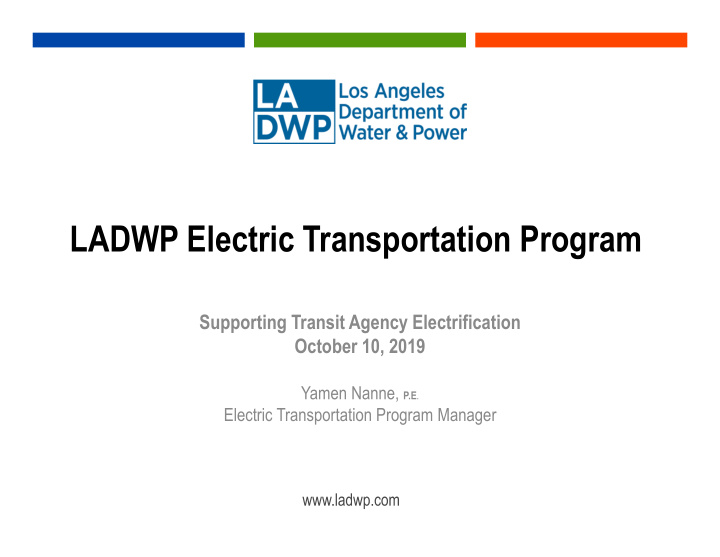



LADWP Electric Transportation Program Supporting Transit Agency Electrification October 10, 2019 Yamen Nanne, P.E . Electric Transportation Program Manager
LADWP’s Strategic Goal: Facilitate Adoption of Electric Transportation in Los Angeles and Southern California Zero-Emissions Vehicle Adoption: • 145,000 EVs by 2022 • 25% ZEVs by 2025, 80% by 2035, 100% by 2050 Publically Available Chargers: • 10,000 by 2022 (4,000 at City & LADWP property) • 28,000 by 2028 Electrification of Busses and City Fleets: • 100% of LADOT and MTA busses by 2030 • 100% of City Fleets by 2028 (where technically feasible) 2
Automaker Efforts • 41 PEV models available in 2019 • 132 EV models projected by 2022 • Automaker investments likely to reach $100B by 2025 • Electrified model commitments announced by: 3
EV Momentum Source: EPRI’s 2019 EV Consumer Guide 4
Vehicle Classes Light-duty Vehicles Medium-duty Vehicles Heavy-duty Vehicles 5
Impact on Power Systems Focus on Home Focus on Work Charging Charging * Graphs courtesy of NREL 6
Bus Charging Infrastructure Plug-in Overhead Wireless Activation Manual Automated Automated Connection Conductive Conductive Wireless Power Range Up to 350 kW Typically 350-500 kW Up to 250 kW Voltage Type AC, DC, and AC + DC DC AC 7
Supporting Transit Bus Electrification LADWP is in the process of establishing a strategy to support transit agency fleet electrification goals. These efforts include: Planning initiative to perform a system‐level forecast to meet the need for distribution system infrastructure upgrades to serve medium‐ and heavy‐duty charging loads. Support through the medium‐ and heavy‐duty charging station rebate to offset the cost of the charging stations and installation for up to $125,000 per station based on the technical specifications and vehicle eligibility. Developing a Memorandum of Understanding (MOU) with LADOT & MTA to offset the cost of purchasing and installing BEB charging stations. Offering the new pilot contract rate to provide innovative options to lower the operational cost to charge BEBs. Support integration of clean grid technologies and optimal load management at charging depots where feasible. Increase customer awareness to begin early communications with Transit Agnecies to better align LADWP planning with transit planning efforts. 8
EV Incentives & Rebates for Customers • Up to $1,000 toward cost Residential EV Charger of charger & installation + Rebate $1000 for dedicated meter Commercial EV • Up to $5,000 toward purchase and installation Charger Rebate of chargers Used EV Rebate • Up to $1,500 toward purchase of used EV (Pending) DC Fast Charger • Up to $75,000 to apply toward the purchase and Rebate installation of the charger • Up to $125,000 toward Medium/Heavy-Duty purchase and installation Charger Rebate of the charger 9
Qualifying Charging Stations: Medium and Heavy-duty EVs • Output power: 6 kW or more for AC charging stations and 20 kW or more for DC MD/HD: New! charging stations Up to $30,000 for AC charging stations Must be purchased and installed between Up to $125,000 for DCFC July 1, 2018 and June 30, 2022 • Connector standard : No requirement • Certification: Certified/listed by NRTL or field tested (recognized national safety standards). Approval by LA Building and Safety Electrical Testing Laboratory (LADBS‐ETL) or testing agency recognized by LADBS‐ETL required for field testing Vehicle and Access Requirements • Vehicles: Must charge on‐road MD/HD plug‐in EVs: Class 3 to Class 8 Vehicles Must acquire at least one new MD/HD EV for each charging station rebate. The vehicle(s) must be eligible for financial incentives by a government agency of the state of California • Access : No requirement 10
Rebate Amounts: Medium and Heavy-duty EV Charging Stations Maximum Rebate Amount Charging Station Type Output (kW) (per charging station) DC Fast Chargers for Light-Duty EVs Tier 1 50 - 99 $50,000 Tier 2 100 + $75,000 Charging Stations for Medium Duty - and Heavy-Duty EVs AC-1 $10,000 6 - 49 AC-2 50 - 99 $20,000 AC-3 100 + $30,000 DC-1 20 - 49 $35,000 DC-2 50 - 99 $60,000 DC-3 100 - 149 $100,000 DC-4 150 + $125,000 11
End-to-end Customer Process Customers may apply for a: – Rebate reservation before completing deployment of charging stations, or – Rebate after completing deployment of charging stations In both cases, customers must submit: – Program application – Required documents (including proof of purchase and installation of qualified equipment) Develop charging Obtain Receive approval Procure charging plans + complete confirmation Apply for rebate from LADWP on stations; finalize submittal from LADWP’s EV reservation reservation design package Service Design Submit copy of Submit proof of Deploy charging Apply for permits permits to Apply for rebate deployment to stations LADWP LADWP 6 months from 2 months from permit issue date reservation approval Receive rebate 12
LA’s Bus Electrification Efforts LADWP is an active partner helping transit agencies meet their electrification goals. This supports LA’s Green New Deal Initiative. Source: LA’s Green New Deal, http://plan.lamayor.org/sites/default/files/pLAn_2019_final.pdf Note ote that some of Metro’s electric buses charge outside the LADWP service territory. LADWP worked with Navigant to develop a five-year pilot electric rate with four options to support progress toward the City’s Green New Deal bus electrification goals. The proposed rate also supports electrification of commercial transport fleet vehicles. 13
RATE DESIGN STRUCTURAL COMPONENTS Each rate option consists of multiple components to capture the cost of service. OPTION ELECTRIC CHARGES SPECIAL CHARGES Facilities EV-Bus 1 Demand Energy Service EV-Bus 2 Connection Demand Energy Storage Tier 3 REC EV-Bus 3 Demand Energy Connection Storage Option Peak Tier 3 REC EV-Bus 4 Connection Option Base 14
Recommend
More recommend